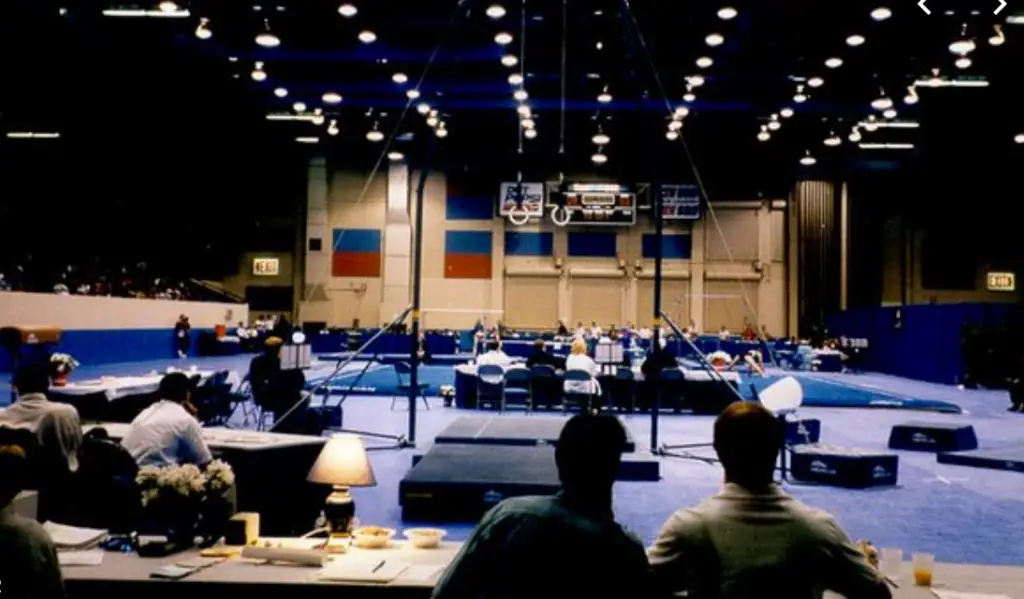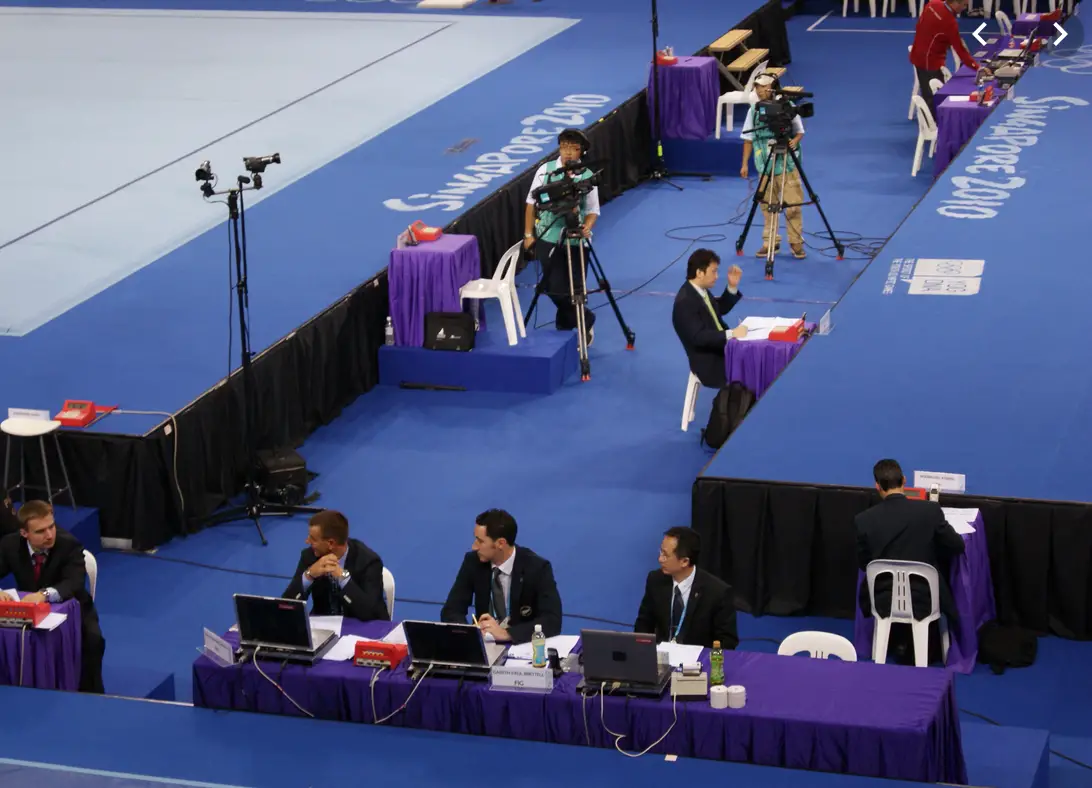Gymnastics scoring can seem to be more than a little confusing at times, especially if you are new to the sport. However, knowing how it works can not only be nice if you are the parent of a gymnast, but it can be an important thing to know in order to help you work towards improving your scores.
Different gymnastics levels are scored differently, with levels 1-8 involving a simple 10.00 point method, levels 9-10 incorporating bonus points, and with Olympic levels involving a totally different scoring system altogether that has only been added in more recent years.
Going over the simpler scoring methods first can be a big help in understanding the more complicated methods that the higher levels use, so let’s start there.
Levels 1-8 Scoring
The first few levels have no official competitions, however in each of these levels that do compete each event has certain skills and maneuvers that are required to be included in the routines. Having all of these elements in your routine gets you a 10.00 point SV –Starting Value – for each of the gymnastics events at a competition.
During your routines the judges will be watching, and for each one of the requirements you fail to have in your routine you get points deducted from that 10.00 SV. Other than that, there are also point deductions for faults like if your splits were not wide enough or you did not perform a certain maneuver correctly.
It is extremely rare to end with a perfect 10.00 point score for an event, with even good gymnasts sometimes ending up in the 8.50-9.50 range. Each of the four events has its own score which is then added altogether at the end of the competition.

The most this can be is 40.00 if you did perfectly on all four events, but a good gymnast should be able to get in the mid-high 30s. This is sometimes called the final score, but is more often referred to as a gymnasts AA – All Around – score. Therefore it is possible to have a gymnast who does really well on two or three of the events but still has a low AA if her score is low on the other events.
Levels 9-10 Scoring
These two levels are similar to the previous ones, however they start incorporating what are known as bonus points. In level 9 the scoring starts at a 9.70 point SV if all of the required skills and maneuvers are in the routine, with level 10 starting off at a 9.50 point SV.
Level 9 gymnasts earn the extra points they need to get to their 10.00 from putting together certain connected maneuvers. In this level the highest skill difficulty that is counted is a C, meaning that even if you do a skill that is rated a difficulty of a D or E it will still be counted as a C.
The points that you get for some of the combinations depend on what you are combining. For example, a combination maneuver that combines two C skills can be worth 0.20 points if both of them have either a turn or flight element to them, but if only one of the C skills has a turn or flight the connection will only be worth 0.10 points.
Level 10 earns the extra points that it needs from both connections and by having extra D or E elements. A level 10 routine has to have both of these since connections only give a maximum of 0.40 points and the difficult elements can only give 0.40 points. However, this is made easier thanks to the fact that both of them count even in the same maneuver.
For example, if you were to have a combination maneuver that has a B skill + an E skill, you would get the bonus points for both the combination and you would also get the points for having the E skill. Since level 9 competitions only count connections, and even then only up to C, you would get the same bonus points that you would get if you did a B + C connection and would get nothing for the E skill.
The vaults are scored in an entirely different way, with each particular vaulting maneuver having its own SV. These numbers stay the same at level 9 and 10 with a basic handspring vault being 8.80 and other more difficult ones like the Yurchenko layout 1/2 having a 10.00 SV.
One thing to keep in mind is that the maximum score that you can get here is still a 10.00. This is in part because you still will be having deductions if your moves are not done perfectly, but it means that even should you do everything perfectly and include a lot of connections and high skills in your routines that you will still get just a 10.00 score.
Elite And Olympic Scoring
In order to help gymnasts to reach their full potential these levels have no limit on the amount of points that you can get. Like with level 10 gymnastics, you will get points both for the connections you have in your combination moves as well as points for the difficulty of the skills you do. Each level difficulty in skills will have its own points that it gets.
For this type of scoring there are two sets of judges. One set of judges will be looking at what your connections are and the skill difficulty of the maneuvers that you are doing. The other set of judges will be looking at how well the gymnast performs these maneuvers.
The performance points have a 10.00 SV for each of the routines besides the vault, and if you were to do all the moves perfectly you would get 10.00 points here. These are called the “execution” points for how well the gymnast executes the different maneuvers in their routine. Any faults or errors in the gymnast’s execution are taken out of this score.
The other set of judges will be determining your difficulty score. Each maneuver, except for the ones on the vault, is usually worth somewhere between 0.10 and 0.70 points. Each of these skills can be combined, giving you points for the connections. In this type of scoring, however there are also a few more factors to consider.
One of these is the fact that there are also either four or five different element groups depending on the event. For each of these elements that you include you get a bonus of 0.50 points in addition to the points that you get for doing that skill. Next, you should also take into consideration that only the points for the 8 highest skills that you do are counted and that three of these have to be dance moves.
The vault event, like with levels 9 and 10, gives each specific vault a specific number of points. However, in this system in addition to those points you also start off with the 10.00 points for your execution. Any mistakes you make are deducted from this score. At the end of your vault, the points from both of these are added together as your score for that vault.
Finally, there is the fact that you also get to do two vaults. At the end of your second vault these scores are added together and then divided in half to get your average. This average is your final score for the vaulting event. For example if you scored 15.80 points on your first vault and then 15.60 points on your second vault your final score would be 15.70 points.
At the end of all four events these scores are once again added together. This is your AA score and, if you get around 15.00 points for each of the events, you can get 60.00 AA which is much higher than the old method where if you were perfect you could get an 40.00 AA. While this is by no means a complete manual on how these competitions are scored, it should at least help you in the right direction.

